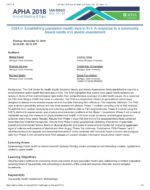Cores and Projects
Abstract
Background: The Flint Center for Health Equity Solutions’ Needs and Assets assessment (NAA) identified the need for a comprehensive public health data resource in Flint. The NAA highlighted that current local public health datasets are lacking in terms of their methodological rigor and/or their comprehensive coverage of public health issues. As a response, the Flint Area Study’s (FASt) first wave is underway. The FASt is a longitudinal inter/multi-generational cohort study designed to assess environmental exposures and elucidate their long-term effects on Flint residents. Methods: The FASt uses a random probability sample and has three assessment phases. Phase 1 involved compiling a list of 400 inhabited households from random block-faces and collecting qualitative data on Flint neighborhoods. Phase 2 involved using the NIfETy Method to assess social- and physical-environmental conditions at the Phase 1 households. Phase 3 will consist of residential surveys that measure for physical/behavioral health, multi-level social dynamics, and biological specimen
collection every three years. Results: Results from Phase 1 show that one-third of the assessed block-faces contained fewer than two inhabited households. Results from Phase 2 show geographical clustering of evidence of potentially protective environmental factors, levels of physical disorder and levels of social-environmental risk (including aggression, signs of violence and presence of alcohol and other drugs). Phase 3 is underway. Conclusions: FASt Phases 1 and 2 identified locations for targeted environmental intervention. Once combined with individual health outcome and biological data from Phase 3, the comprehensive FASt dataset will provide valuable information about unmet health needs.
collection every three years. Results: Results from Phase 1 show that one-third of the assessed block-faces contained fewer than two inhabited households. Results from Phase 2 show geographical clustering of evidence of potentially protective environmental factors, levels of physical disorder and levels of social-environmental risk (including aggression, signs of violence and presence of alcohol and other drugs). Phase 3 is underway. Conclusions: FASt Phases 1 and 2 identified locations for targeted environmental intervention. Once combined with individual health outcome and biological data from Phase 3, the comprehensive FASt dataset will provide valuable information about unmet health needs.
Long Description
Learning Areas:
Epidemiology Public health or related research Systems thinking models (conceptual and theoretical models), applications
related to public health
Learning Objectives:
Describe select methods for evaluating needs and assets around population health data, establishing a random population
sampling frame of households, and conducting an inventory of the social and physical (dis)order around sampled
households.


